North America boasts an impressive diversity of Amanita mushroom species. Amanitas are identifiable by their stately appearance, cap and stem decorations, and white spore print. North America holds a rich and varied group of species, with around 120 species currently recognized. Worldwide, there are over 600 Amanita species! Some Amanitas are extremely dangerous (deadly!), and others are edible.
If you’re interested in foraging the edible species, it is imperative to know the toxic species so you don’t make any mistakes. Also, if you forage any type of gilled mushrooms, you should know the deadly species like the back of your hands so you don’t make any errors in judgement.

Jump to:
All About Amanita Mushrooms
The genus Amanita is part of the family Amanitaceae and includes several hundred species of mushrooms. In North America, the Amanita genus has around 120 species found across the continent.
Many people incorrectly assume that all Amanitas are dangerous because two of the most deadly mushroom species of all are in this group: the death cap and the destroying angel. It gives the other Amanitas a bad rap which bothers a lot of Amanita enthusiasts. They aren’t all dangerous, but it is true you should approach this genus with respect. Instead of maligning all the Amanitas, it’s good to learn which ones are extremely dangerous so they can be avoided. Many species in this genus are downright beautiful, with attractive colors and interesting cap decorations.
Amanita species are recognized by several distinctive features:
- Pale gills (most often white) that are free from the stem
- White spore prints
- Lots of Amanitas have partial veils covering the gills when they’re young. As they grow, the veils break and leave a ring or skirt around the stem.
- Many Amanita species have a ring or skirt around the upper stem.
- Many Amanita species have a volva – a cup around the base of the stem from which the mushroom emerged.
- Many Amanita species have warts or patches on their caps.
- Dry caps (as opposed to slimy caps in the related genus Limacella). The caps often get sticky when wet, but this is different from being slimy.
- The shape of the stem base, which may be bulbous or gradually tapering, is crucial for identification.
- Always grow from the ground. Amanita mushrooms do not grow on wood or from trees.
- Do not grow in shelves or clusters; most often, they are singular. However, sometimes they will fruit in small, close groups.

Amanitas play an important role in forest ecosystems through their mycorrhizal associations. These fungi form complex symbiotic relationships with the roots of trees and other plants. In these partnerships, the mycelial network of the fungus provides extra water and nutrients, such as phosphorus and nitrogen, to the plant. In return, the plant supplies carbohydrates produced through photosynthesis.
Amanita muscaria, for instance, forms mycorrhizal associations with a range of hardwood and softwood trees, most often birches, pines, and spruces. This species can significantly enhance nutrient absorption for its tree partners. For example, up to 80% of the nitrogen and phosphorus used by some tree species is derived from mycorrhizal partnerships.
The geographical “hot spot” with the greatest diversity of Amanitas in North America, and perhaps the entire world, is the Southeastern/Gulf Coast regions of the United States.

Amanita Mushroom Identification
Habitat and Season
There is no one habitat or season for Amanita mushrooms, as their seasonal appearance depends on the species itself and its preferences. Every species (and remember, there are hundreds) has its own timeline. Some appear in spring, others in summer or fall, and in warmer regions, even winter.
Amanitas are widely distributed across North America. Their distribution patterns are closely tied to their symbiotic relationships with specific tree species. One key point for all species, though, is that they grow from the ground. They never fruit from trees or dead wood.
Amanita Mushroom Identification and Key Features
Volva Egg Sac
Most amanitas start out encased by a universal veil which make them look like white eggs laying on the ground. It’s kinda hard to imagine that a mushroom emerges out of this egg, but it does. The egg isn’t actually an “egg”, but is a thin membrous skin that covers the entire mushroom as it emerges from the soil. Once above the soil line, the universal veil membrane breaks and the cap and stem emerge.
The reason so many amanita species have rings around the stems, cups at their stem base, and warts on their caps is because these are remnants of the universal veil.

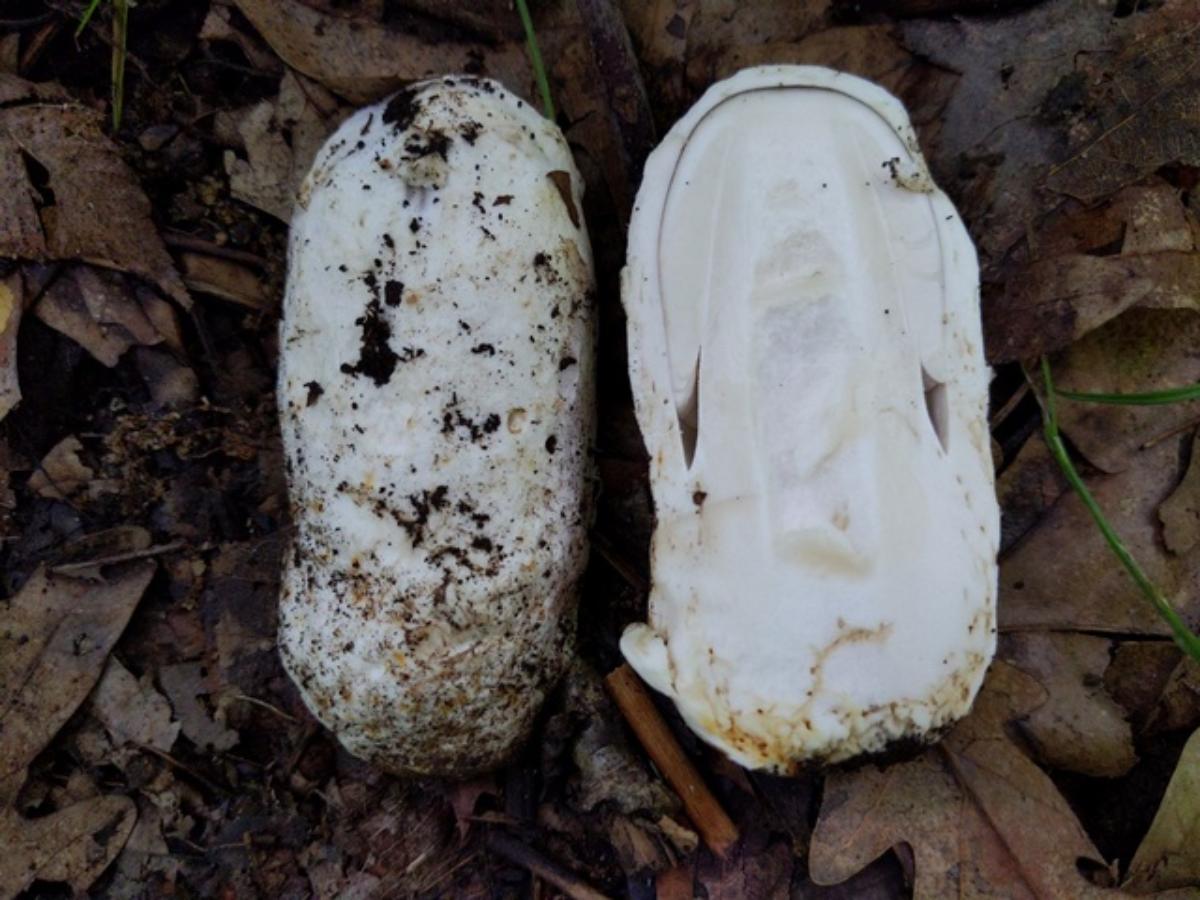


Cap
The cap of Amanita species often serves as a prime identifier. Its size typically ranges from 2- 6 inches in diameter, with colors varying from pale green and yellowish-green to olive green, bronze, red, yellow, and white. The cap surface is sticky when wet and can usually be easily peeled.
Some Amanitas, like the fly agaric (A. muscaria), have distinctive bright caps with spots or warts. These spots, ranging from white to whitish-yellow, are remnants of the universal veil. The cap margin may be vertically lined around the edges, particularly in mature specimens.




Gills
All Amanita species have white to off-white or yellow gills that are free from the stem. There are always long gills, that go the full length of the cap underside and a mix of much shorter gills, that only go partway. The gills are usually initially covered by a partial veil during the mushroom’s early development stages. The veil is white and cobweb-like and easily broken.

Stem and Volva Structures
The stem base is crucial for Amanita identification. It’s important to carefully dig out the underground stem base to examine its features. Look for:
- Shape of the stem base (bulbous or gradually tapering)
- Presence of a volva (cup around the base of the stem) and its characteristics
- Any rings around the base of the stem
The stem often has a skirt-like, floppy annulus just below the cap. This ring is the remnant of the universal or partial veil. Sometimes, it is just a ring without much of a skirt, and other times, it is a quite long and flowing skirt. It varies widely by species. There are even species with double skirts.
Unfortunately, some species with less-defined skirts or rings can be hard to discern. The rings may fall off or get washed away in heavy rains or other extreme weather. Always look for the ring or skirt, but don’t use it as the sole identifier for any species.
Amanita stems are usually fibrous and don’t snap easily. Sometimes, they are hollow. This often happens in maturity.
Odor and Taste
Some Amanitas have distinctive smells and tastes, especially when mature. It varies widely.
Spore Color
Amanita species almost always have white spore prints.
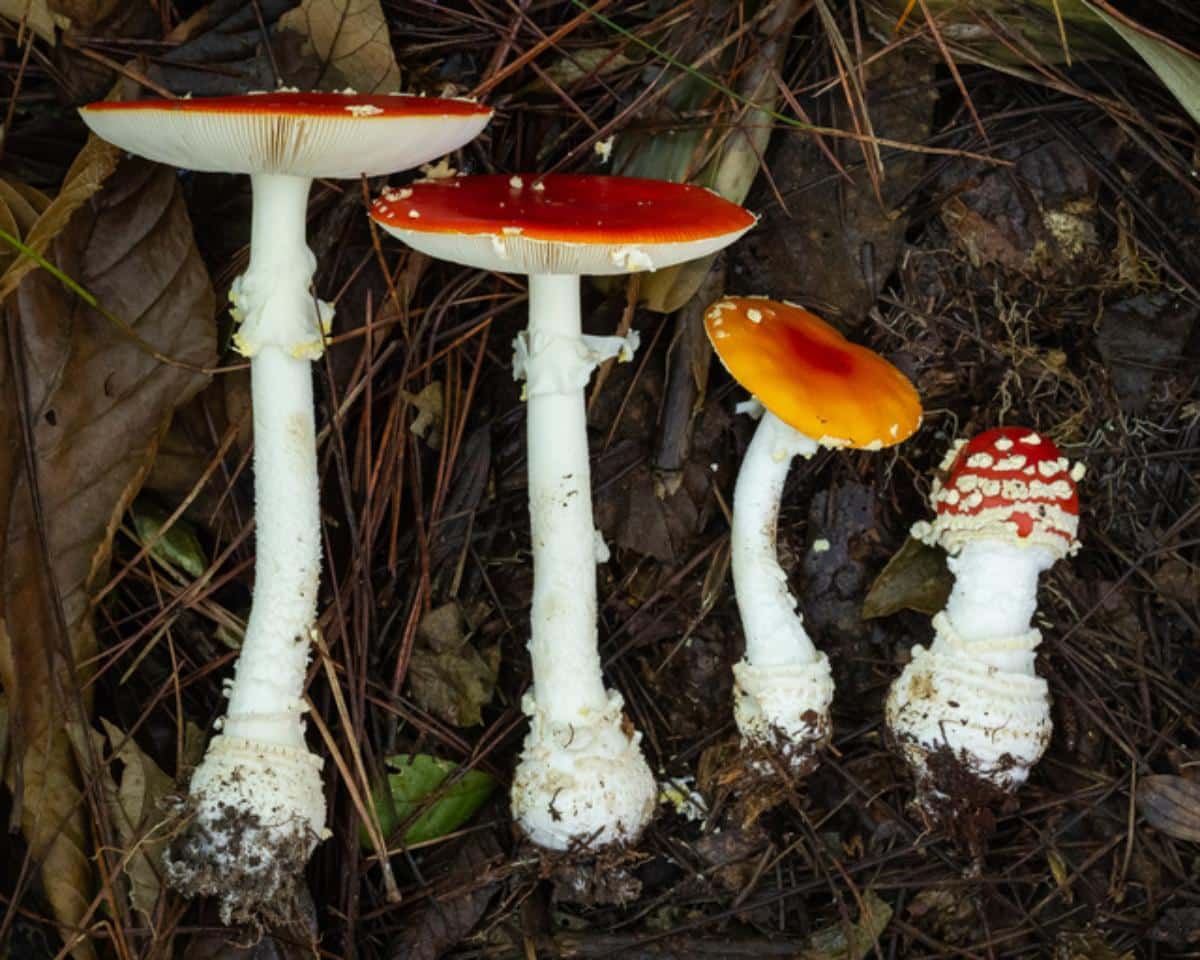



When looking at a mushroom you think is an Amanita, follow this list of questions:
- Is it growing from the ground?
- Are there trees nearby?
- Does it have a round cap and gills?
- Is the stem in the center of the cap?
- Are the gills white or whitish (some might be light yellow, but the gills are never darkly colored)?
- Do the gills not touch the stem?
- Is there a ring or skirt around the upper stem?
- Is there a cup around the base of the stem?
- Is the stem bulbous or tapered?
- Are there scales, patches, or “warts” on the cap?
- Is the spore print white?
If the answer is yes to many of these questions, there’s a good chance you’ve found an Amanita mushroom. The next step is figuring out which of the almost one hundred it could be! Some are easier to figure out than others, but knowing the family is always a good first step.

North American Amanita Mushrooms
This is not a complete guide! This collection of Amanita mushroom descriptions covers some of the most interesting types of Amanitas found in North America. If you don’t find the one you’re looking for here, the Studies in Amanitaceae website is an incredible resource for all things Amanita. We start with the most commonly recognizable and known species and then break the species up by region.
Fly Agaric (Amanita muscaria species complex)
The fly agaric is the most iconic species of toadstool. It is highly recognizable and commonly seen in popular culture, such as in video games like the Mario franchise, and has been featured in television shows like The Smurfs franchise. However, this poisonous mushroom has also been the cause of hospital admissions for children who were drawn to it due to its presence in popular media.
This mushroom is toxic but usually not deadly. It contains hallucinogenic properties that often also cause gastrointestinal distress. In some cultures, it is parboiled and eaten.
The fully grown fly agaric has a bright red cap measuring around 3-8 inches in diameter. This is a large mushroom with a cap that is covered with small pyramid-shaped warts, which are remnants of the universal veil. A distinctive yellowish layer can be seen under the veil. The cap goes through different stages, starting as rounded and eventually opening up to become flat.
The gills and spore print are white. The stem is white and is 2-8 inches tall, with a fibrous texture. The base of the stem is bulbous and has remnants of the universal veil in the form of rings or ruffs. There is a white ring around the upper part of the stem. The ring may become wider and more droopy as the mushroom ages. There is typically no distinct scent, only a slight earthy aroma.
Fly Agarics vary quite a bit in their appearance, color-wise. There are several subspecies in North America. These species include a yellow-capped version named Amanita muscaria var. guessowii, a reddish-orange capped version called Amanita muscaria subsp. flavivolvat, and a pale-orange capped species named Amanita muscaria var. inzengae.



Death Cap (Amanita phalloides)
The death cap mushroom is one of the most poisonous mushrooms in the world. It is responsible for the majority of mushroom poisoning fatalities. The mushroom is native to Europe but has spread to various parts of the world, including North America and Australia. It typically grows near oak, chestnut, and pine trees.
The death cap has a pale green to olive cap, though it may also be brownish or whitish. The cap starts out rounded but then opens up and flattens with maturity. It ranges from 2-6 inches wide and is smooth without decorations on it.
Death cap mushroom gills are white. They are closely packed together and not attached to the stem. The death cap stem is white, sometimes with a yellowish or greenish tint. It is 3-6 inches long and bulbous at the base. The base is also surrounded by a white egg-like volva, which looks like a cup. Around the top of the stem is a skirt-like ring. It has a slightly sweet smell and a white spore print.

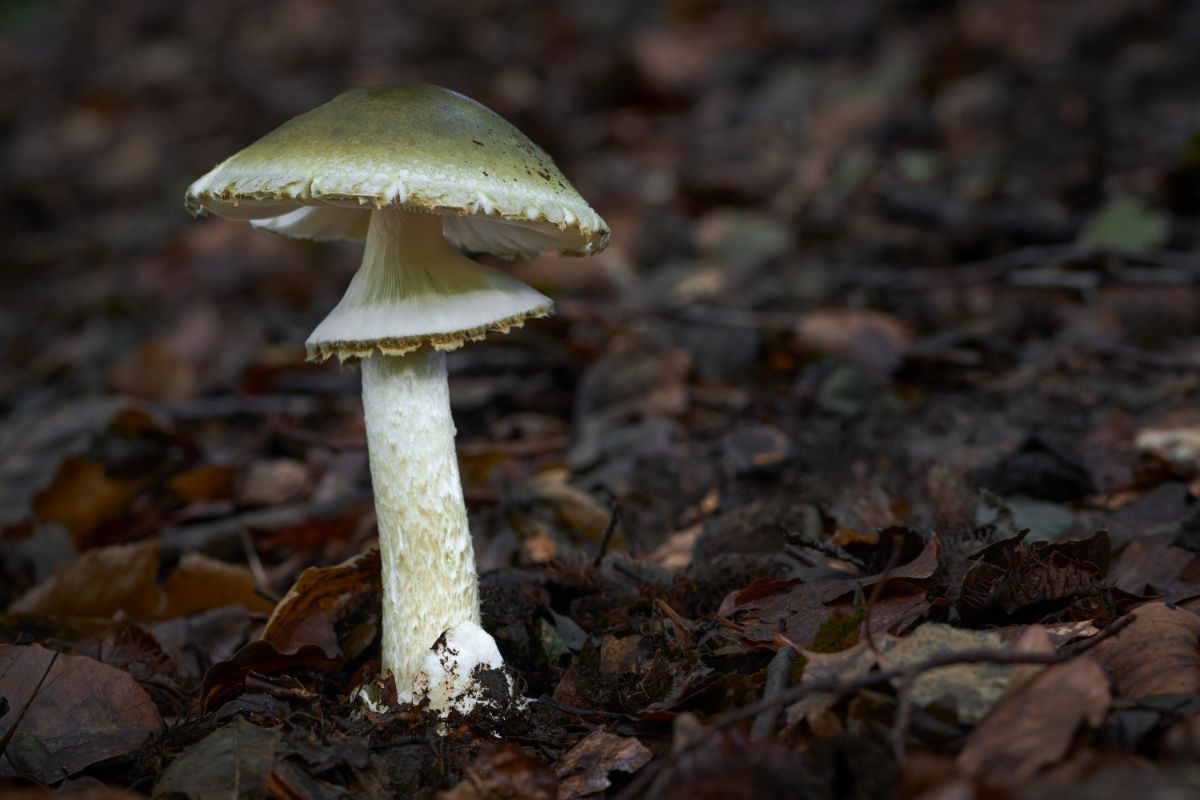
Destroying Angel
The name Destroying Angel refers to several species within the genus, including Amanita bisporigera, Amanita virosa, and Amanita ocreata. These species are closely related and share similar toxic and destructive properties. A. bisporigera occurs in eastern North America, A. ocreata occurs in western North America, and A. virosa is a European species. This is a very dangerous species that can be confused with edible species, like the meadow mushroom.
These mushrooms are characterized by their stately appearance and pure white color, including the cap, gills, and stem. They do look like white angels in the forest! The cap is typically smooth and can range from rounded when young to flat as it matures.
The gills are white, free from the stem, and densely packed. The stem is straight with a bulbous base. A skirt-like ring (annulus) is usually present on the upper stem. Around the base of the stem is a white cup-like volva – this may be underground, so make sure to dig up the entire mushroom base.
Destroying Angels are found in wooded areas, often in symbiotic association with trees like oaks, pines, and birches. They typically fruit in the summer and fall.


Western North America Amanita Species
Amanita lanei (syn. Amanita calyptrate) [Coccora, Coccoli, Pacific Amanita]
Commonly called coccora or coccoli, this species is native to western North America. Amanita lanei is often found in coniferous forests, particularly under pine trees.
The cap of this mushroom starts out rounded but then flattens out. It often has a slightly depressed and darker-colored center. It can range in color from brown to orange-brown to a lighter tan. The surface may be smooth or slightly sticky when wet. The cap ranges from 4-10 inches in diameter.
The gills are free from the stem and are usually white to cream in color. They are densely packed and can sometimes have a slight pinkish hue as they age. The stem is 4-8 inches long, usually white or cream-colored. Around the base of the stem is a large cup-like sac, the volva. It may have a ring or annulus around the upper stem, which can be fragile and disappear with age. The spore print is white.
This is an edible species, but it looks a lot like the death cap, so you must be extremely cautious and fastidious when identifying this one.

Amanita novinupta (formally known as Amanita rubescens) [The Blusher]
The Blusher, also known as the “newlywed amanita,” is an edible species with flesh that turns pink when cut or bruised (which is how it got its common name). Like other edible Amanitas, it resembles some dangerous species like the destroying angel and should be foraged with extreme caution.
The cap is pinkish or buff and darkens slightly with age. It ranges from 2-6 inches in diameter. The top of the cap is covered with lots of whitish-to-pinkish patches. The gills of this mushroom are white and crowded and are not attached to the stem. They turn pinkish or reddish when they’re bruised.
The stem is white, 2-6 inches long, and hollow or stuffed. It is often covered with streaks of color that match the cap, as well as cotton fibers below the skirt. Around the top of the stem is a ring-like skirt. The stem may be equal in length or enlarged at the bottom. The base of the stem has several rough collars or rings that stand out.
The blusher’s flesh is white, but it’s distinctive in that it turns pink when exposed to air. It does not have a distinctive smell or taste, and the spore print is white.

Amanita smithiana [Smith’s Lepidella]
This Amanita species fruits in early to late fall, the same time as another much sought-after white mushroom. The similarity in looks between Smith’s Lepidella and matsutake has led to poisonings in the Pacific Northwest. Smith’s Lepidella is highly toxic and attacks the kidneys. This species is typically found in coniferous forests, particularly in the Pacific Northwest of North America.
It has a white to off-white cap that can be sticky or slimy when wet. The cap is usually smooth and can range from 2-6 inches in diameter. The gills are free from the stem and are white, though they turn slightly cream-colored with age. The stem is white, cylindrical, and can be bulbous at the base. It often has a ring, which may disappear as the mushroom matures.

Eastern North America Amanita Species
Amanita frostiana [Frost’s Amanita]
Frost’s Amanita grows in mixed forests, usually with oaks and pines. It shows up in summer and early autumn. It is toxic, though not deadly.
The cap is typically 1-3 inches in diameter. It starts out rounded and becomes flat as it matures. The color ranges from yellow to orange or red, often with a sticky surface, and is covered with white to yellowish warts. The gills are free from the stem, closely spaced, and white to cream in color. The stem is slender, measuring 2-4 inches in height, is white or pale yellow, and has a bulbous base. There is a ring around the upper part of the stem.

Amanita chlorinosma [Chlorine Lepidella]
This Amanita species is known for and named for its strong, distinctive smell – like chlorine. The Chlorine amanita is toxic. It is often found in association with hardwood forests, particularly under oak and other broadleaf trees. This species is known to grow in sandy soils, primarily in the southeastern United States. It appears during the warmer months, especially in summer and early fall.
This mushroom typically has a white to off-white cap that can range from 2-6 inches in diameter. The cap surface is smooth and may have a slight sheen. As the mushroom matures, the cap may flatten out. The gills are free from the stem, closely spaced, and white, and they can darken slightly as the mushroom ages. The stem is white and often has a bulbous base. It can be 4-8 inches tall and usually has a ring or skirt-like structure around the upper portion.

Amanita hesleri [Hesler’s Lepidella]
This species grows in mixed forests, including oak and sometimes pine. The cap ranges from 1-4 inches in width and is white to pallid. It starts out rounded but flattens out with age and has a low, broad, slightly depressed center. The top of the cap is covered in dense brown to dark brownish-gray warts, which are largest over the center and become smaller and more scattered toward the edges.
The gills are crowded, white, and may turn flesh pink with age. The stem measures 1.5-5.5 inches in length. It is white, and the lower half is covered in white scaly fibers left over from the universal veil. The upper half of the stem is also covered in fibers but not as densely. It does not have a strong smell or taste.
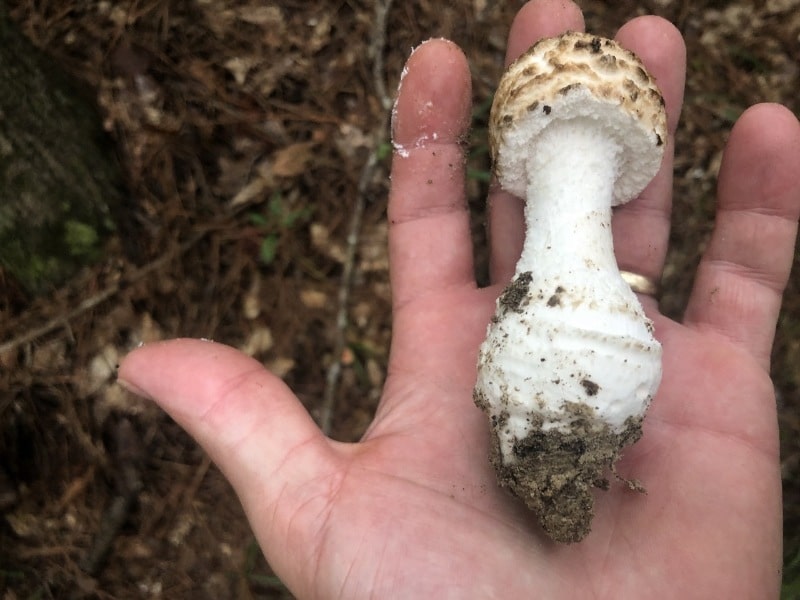
Amanita magnivelaris [Great Felt Skirt Destroying Angel]
Amanita magnivelaris is part of the destroying angel family and is extremely toxic to deadly. It is also a beautiful mushroom! The great felt skirt destroying angel is found in sandy soil around oak, pine, hemlock, beech, and birch trees. It is an uncommon species in its range.
The cap of this mushroom is typically smooth and can vary in color from white to light brown. It is 1.5-5 inches wide and often has a slightly sticky texture when wet. The gills are free from the stem and are white, just like the other destroying angel species. The stem is white and covered in fine to scaly fibers. The stem also features a prominent ring, which is a remnant of the partial veil that covers the gills in immature specimens. This ring is actually a wide and outspread skirt, much thicker and more distinctive than other destroying angel mushrooms,
The base of the stem is bulbous. Around the base of the stem is a white cup, the volva. There is no reported smell, and the spore print is white.
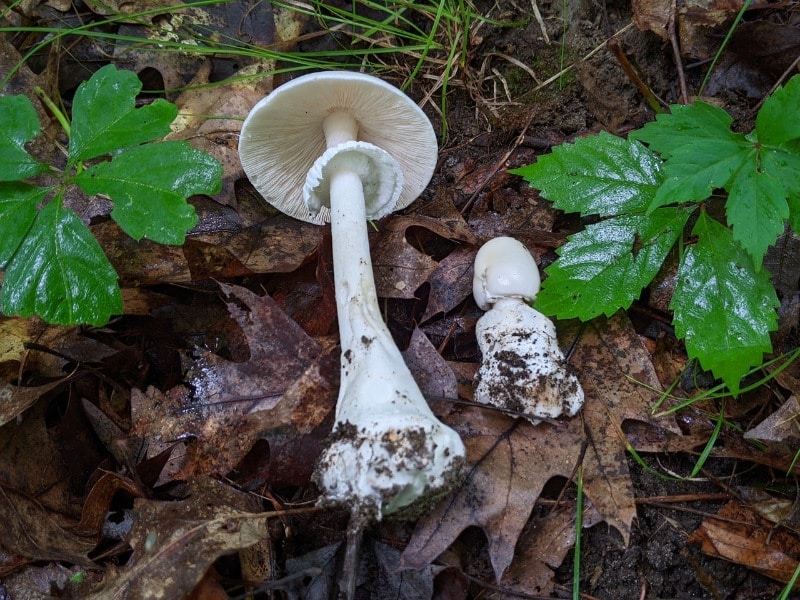
Amanita brunnescens [Cleft-Footed Amanita]
This distinctive Amanita with the brown cap and very split (cleft) stem base is common and widespread east of the Rocky Mountains. Its toxicity is unknown, so it is best to avoid it. It grows in deciduous and mixed forests in summer and fall.
The cap is typically brown and can range from 2-4 inches in diameter. It starts out rounded and flattens with age, and it often has a slightly sticky surface when moist. The cap might have reddish-brown stains, and it often looks mottled or streaked. It may also have a few random warts or patches strewn over it.
The gills are white, free from the stem, and densely packed. The stem is white to pale brown and has a distinctive cleft or split at the base, which gives the mushroom its common name. However, sometimes the cleft isn’t always that chiseled and it can be difficult to ID. The whole stem bruises reddish-brown when handled. Around the upper part of the stem is a white ring or skirt that may also have reddish-brown tinges. This species has a volva at the base of the stem.

The Ringless Amanitas
This group of Amanita mushrooms is commonly called the grissettes. They are difficult to differentiate from each other, but there are key points that put them in this group.
- They do not have a ring or skirt around the stem.
- The gills are white or whitish and do not touch the stem.
- They have a cup around the base of the stem.
- The caps are smooth without decorations, warts, or patches.
- Most have striated caps, which means the edges of the cap are vertically lined (an imprint from the gills underneath).

Edible Amanita Species
While many Amanitas are known for their toxicity, a few are prized edibles. However, extreme caution is necessary when foraging for these mushrooms.
Caesar’s Mushroom Group
These delicacies, known for their robust flavor and buttery texture, are highly sought after in many regions. They are characterized by bright orange-red or yellow caps and lack the distinctive warts of their poisonous relatives. In North America, there are several Caesar amanita species – the true Amanita caesarea is a European-only species and does not grow in North America.
Caesar mushrooms have bright, undecorated caps with lines all around the cap edge (striation). They grow from a white cup-like sac (the volva) and have a ring around the stem. Unlike most other Amanitas, the gills are yellow or pale yellow. The stems are usually streaked as well, with very fine fibrous material clinging to them.


Blushers
The Blushers get their name from their tendency to turn pink or reddish when cut or bruised. Blushers do not have a cup-like sac around the base of the stem, but they do have a ring on the stem. They closely resemble the toxic Panther Cap, so clear and accurate identification is crucial.
In North America there are four (likely more) blushing amanitas:
- Amanita flavorubescens – bright yellow or yellow-brown cap with yellow warts. [east of the Rocky Mtns and in Arizona]
- Amanita amerirubescens – a catch-all for the well-known Blusher that occurs in Europe (Amanita rubescens). This is likely a group, not a single species. Caps are reddish-brown with white to reddish warts.
- Amanita rubescens var. alba – whitish cap with yellowish to grayish warts, turns pinkish or reddish with age [north eastern N. America]
- Amanita novinupta – white to pinkish tan cap with whitish to pinkish warts or patches. [West Coast, including Arizona and New Mexico]

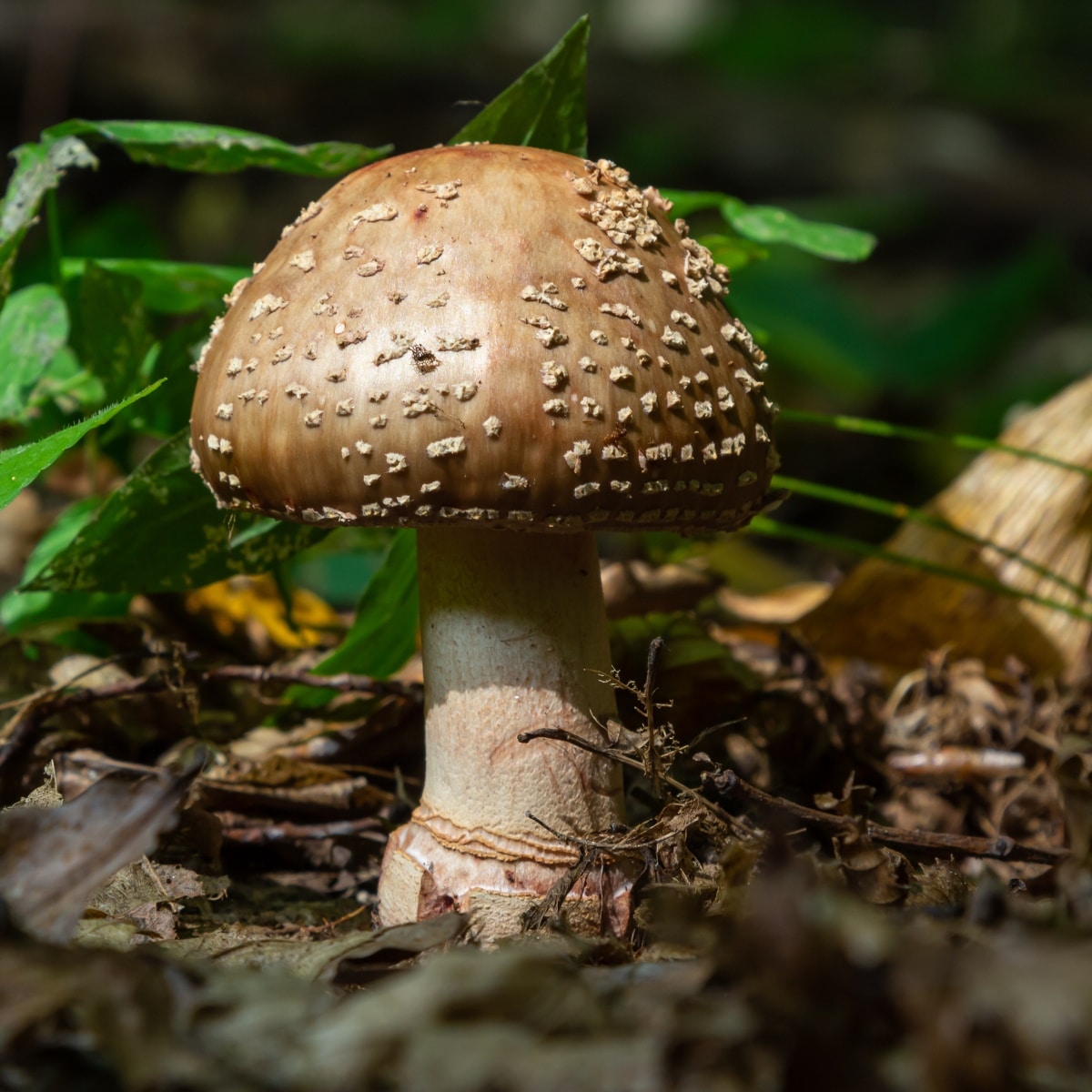
Common Amanita Look-alikes and Differentiation
Several Amanita species can be mistaken for edible mushrooms, making accurate identification crucial. Remember, accurate identification of Amanitas requires assessing a range of features, including physical size, shape, texture, colors, smell, taste, and growing habitat. It’s crucial to avoid simply looking through pictures and choosing the ‘closest fit’, as this approach can lead to misidentification. Always consult expert resources and, when in doubt, avoid consumption.
Paddy Straw Mushroom (Volvariella volvacea)
The death cap (A. phalloides) may be confused with the edible paddy straw mushroom, but the paddy straw mushroom is not commonly found in North America. It is not native to this continent but has been introduced through wood chips or compost. And, that is where they tend to grow, in human created spots like greenhouses where there is good mulch, compost, or wood chips. They may also appear in garden beds.
There have been a number of poisonings of people foraging death caps, thinking they are paddy straw mushrooms or other edible species. If you are in North America and think you’ve found the paddy straw mushroom, look again and make sure you’re not holding a death cap! A spore print will point you in the right direction — paddy straw mushrooms have a pinkish-brown spore print and the death cap has a white spore print.


Puffballs
Young amanitas might be mistaken for edible puffballs. Many amanitas start out as white “eggs.” These eggs are actually a volva (a veil) that covers the entire mushroom as it forms. When you cut the volva egg open, you’ll usually see the outline of gills and stem and cap forming.
At this volva stage, the puffball and baby amanita mushrooms look very similar. This is just one reason it is essential to always cut puffballs in half – to check for gill formation, which means it’s not actually a puffball.


Agaricus Species
The white form of A. phalloides (the death cap) can be confused with edible Agaricus species, especially when young. Agaricus species are widespread (the common button mushroom is an Agaricus species). They also have rings around their stems and have whitish or brownish caps.
The primary difference is that Agaricus species don’t have white or whitish gills. When they’re young, their gills might be pinkish, and that can be confusing. However, with maturity, their gills turn a deep chocolate brown to medium brown, something an Amanita will never have. Secondly, their spore print is also brown and never white like the Amanita. If you’re ever unsure, do a spore print!

Parasols
Parasol mushrooms are very similar to amanitas. They’re tall and stately, with wide caps and slender gills. And, they often have patches or scales on their caps. There are a few key differences, though, that make differentiation easy.
Parasols also grow on the ground, but they are saprobic, not mycorrhizal. This means they don’t need trees around, and they’re often found growing in meadows, fields, lawns, and along roadsides. Parasols have rings around the upper portion of their stem, like many Amanitas, but their ring is movable. This means you can slide it up and down the stem; this is not something you can do with Amanita rings.
The final primary difference is that they don’t have a sac-like cup around the base of the stem. The parasol’s stem is usually bulbous but not cupped.

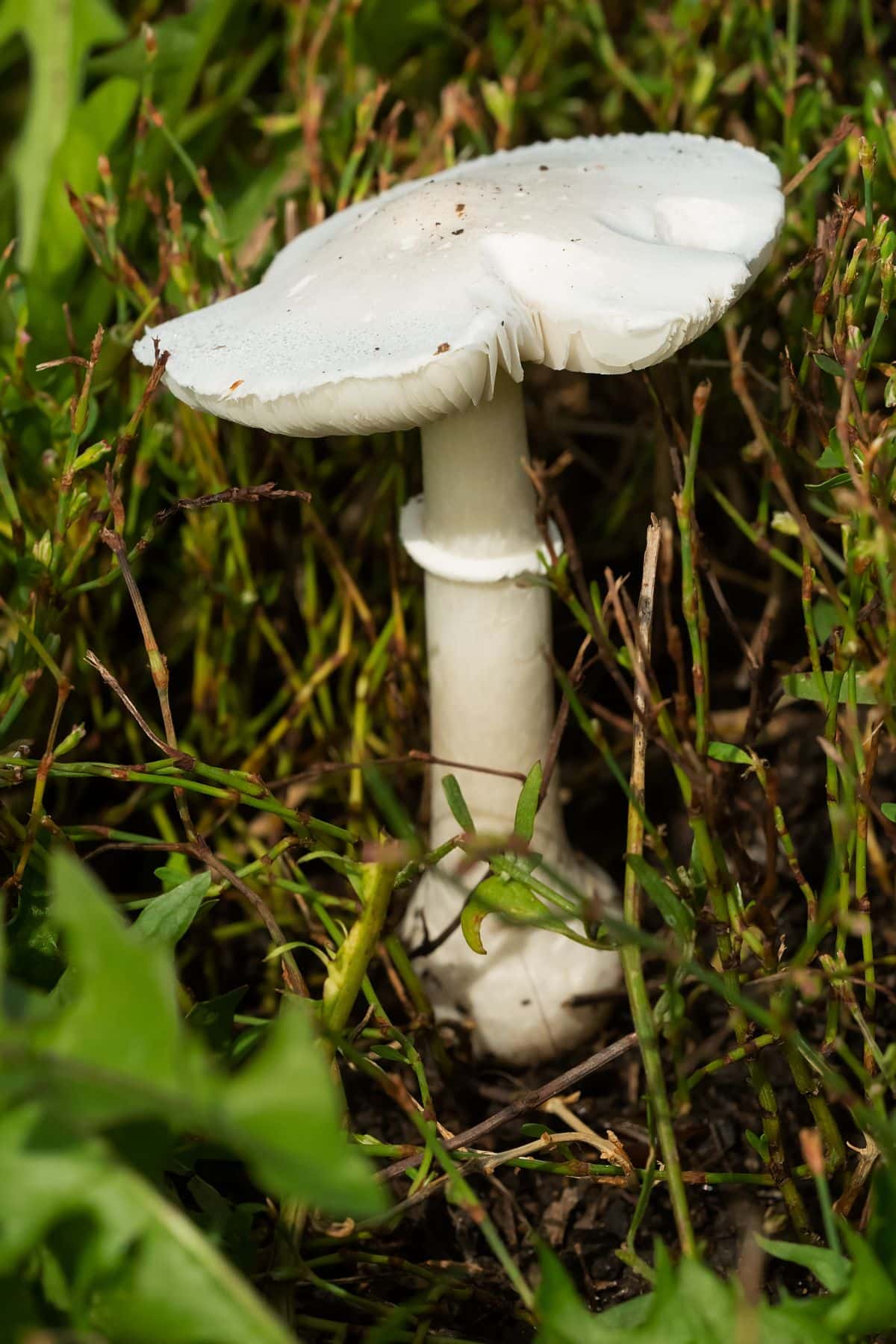
Amanita Mushrooms Toxins and Poisons
Amanita species are responsible for 90% of fatal mushroom poisonings worldwide. The most notorious among these is Amanita phalloides, the death cap. This species is extremely poisonous and can be fatal even when consumed in small amounts. Other deadly Amanita species include Amanita bisporigera and Amanita ocreata, known as the destroying angels, which are considered the most toxic North American Amanita mushrooms.
Amanita Mushroom Toxin types and effects
Amanitas contain two main types of toxins: amatoxins and phallotoxins. Amatoxins, particularly α-amanitin, are the primary cause of severe liver and kidney damage. These toxins inhibit RNA polymerase II, interfering with DNA transcription and protein synthesis in cells with high metabolic rates, such as liver cells. Phallotoxins cause gastrointestinal symptoms in the early stages of poisoning.
The toxicity of these mushrooms is particularly dangerous because amatoxins are heat-stable and cannot be destroyed by cooking, freezing, or drying. A single mature fruit body of Amanita bisporigera can contain 10-12 mg of α-amanitin t, which is more than enough for a lethal dose in humans.
In addition to the toxins themselves, the way they attack the body is also intricate and very dangerous. There is almost always a period of latency when the poisoning symptoms dissipate almost completely. This usually leads people to believe they’re okay or recovering. And this leads them to not seek help. However, there is serious trauma going on during this phase, which can lead to deadly liver and kidney damage.
Symptoms of Amanita poisoning
Amanita poisoning typically progresses through three distinct stages:
- Gastrointestinal phase: Occurs 6-24 hours after ingestion, characterized by nausea, vomiting, diarrhea, and abdominal pain.
- Latency period: A deceptive phase where symptoms subside, lasting 24-72 hours.
- Hepatorenal phase: Liver and kidney damage become apparent, with symptoms including jaundice, coagulopathy, and potentially hepatic encephalopathy.
In severe cases, symptoms can progress to complete liver failure within 3-7 days after ingestion.
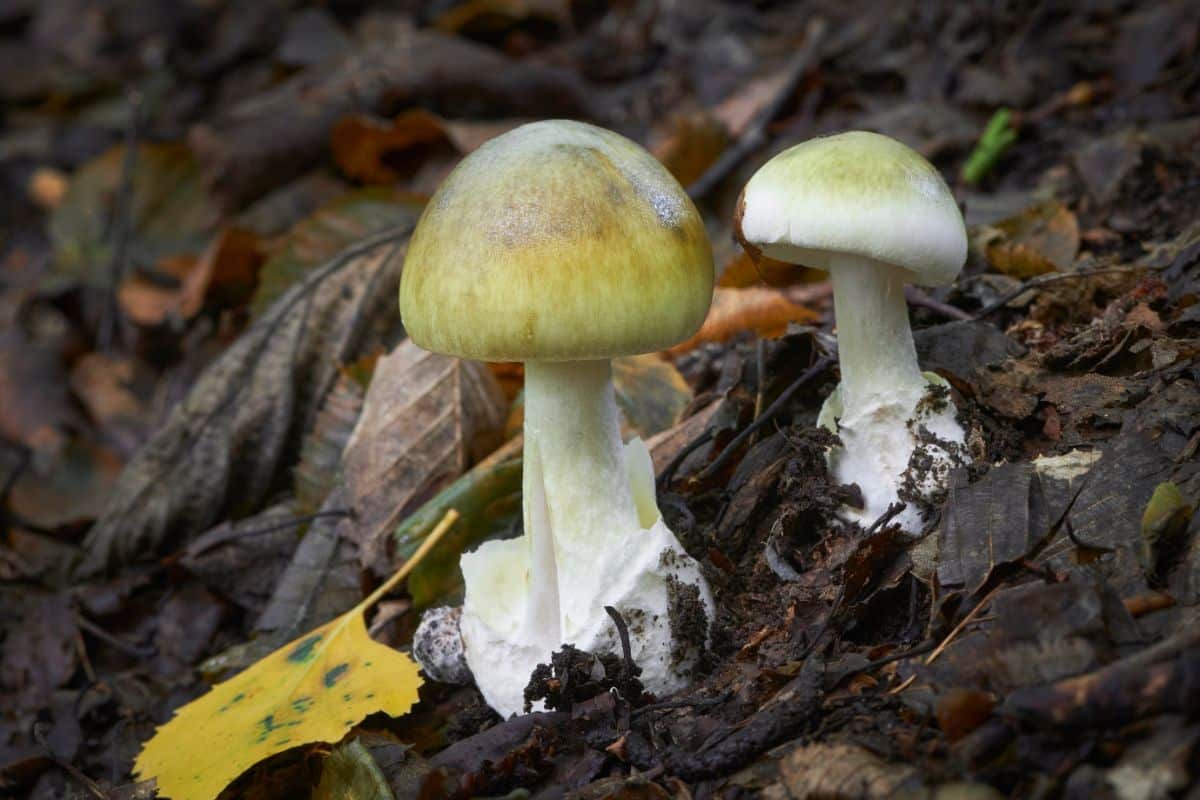
Treatment and medical interventions for Amanita poisoning
Treatment for amatoxin poisoning is primarily supportive, as there is no specific antidote. Key interventions include:
- Aggressive intravenous fluid and electrolyte therapy to maintain hydration and correct imbalances.
- The administration of activated charcoal is used to reduce toxin absorption, especially if given early after ingestion.
- Use of N-acetylcysteine, high-dose penicillin, and silymarin (milk thistle extract) to potentially mitigate liver damage.
- Liver function monitoring and supportive care in an intensive care unit setting.
- In cases of severe liver failure, liver transplantation may be the only life-saving option.
Early diagnosis and aggressive treatment are crucial, as mortality rates can be as high as 60% if left untreated. However, with prompt and appropriate medical intervention, fatality rates in developed countries have been reduced to less than 5% of all cases.
There is some interesting research happening now with a potential antidote for amatoxin poisoning but it isn’t completed yet. We look forward to updating this article in the future if it gets approved.

Common Questions About Amanita Mushrooms
Are there any species of Amanita that are safe to eat?
Yes, some Amanitas are edible and, in fact, among the top culinary species. However, it is recommended not to consume any Amanita mushrooms unless you are absolutely certain of their species due to the potential for confusion with toxic varieties.
Is it dangerous to touch an Amanita mushroom?
No. Touching a mushroom, even the most deadly ones, will not hurt you. The toxins must be ingested (eaten) to cause harm. You can pick and study destroying angels and death caps without worry. Just don’t eat them! If you have children or pets who might put things in their mouths, make sure the poisonous species are not in their reach.

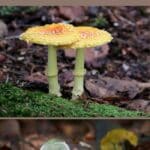
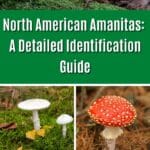






John Paiva says
What an incredibly beautiful and informative site! With your expertise, might you know if what looks like a white mold growing on a tree trunk is a mushroom or something else? I’ve seen this white pattern that looks like a thin fungus growing on many trees in the PNW. Thanks for your consideration, John
Jenny says
Thank you! Molds are hard to ID but if you want, you can post some pics on our facebook group and possibly someone will know. Pls make sure to read the pinned/featured post to include all necessary info https://www.facebook.com/groups/340690111324762
Peter says
Hi Jenny,
Your web site is very informative! Can you help me determine the species of mushrooms growing in my yard in upstate NY (Fair Haven), beneath lots of oak trees? I’m pretty sure it’s an Amanita but can’t figure out the species.
https://flic.kr/p/2rew85v
https://flic.kr/p/2rexfja
Jenny says
Can you share these in our facebook group – https://www.facebook.com/groups/340690111324762 – and make sure to read the id request rules in the pinned/featured post — need to see cap, gills, stem, stem base etc